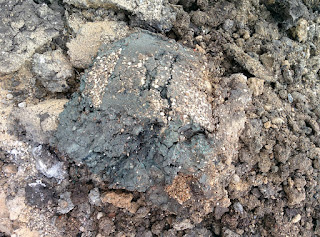First job was to dig the rubble and other crud out of the soil:
What is that blue stuff?! Most heroic chunk of rubble was a piece of concrete the size of a truck wheel (about 600x600x250 mm) which once broken up included these bits:
(note standard house brick buried under there for scale). Suffice as to say multiple ikea bags were filled with rubble. And many many weeds. One of the major tasks was to improve the drainage - over the winter we had a lot of water pooling on the surface as a result of the local "Oxford clay" geology. The major part of this was digging in this lot:
(note standard house brick buried under there for scale). Suffice as to say multiple ikea bags were filled with rubble. And many many weeds. One of the major tasks was to improve the drainage - over the winter we had a lot of water pooling on the surface as a result of the local "Oxford clay" geology. The major part of this was digging in this lot:
In total we put 10 x 850 kg bags of sharp sand in - the bags also turned out to be useful to collect up the rubble and other crap: we filled about 3. Next phase according to the RHS as linked above is to rotavate (also something of a challenge given the clay):
And then dig in organic matter (i.e. well rotted horse poo). [Interesting footnote: apparently this is not just to improve the nutrients in the soil - it also encourages worms which in turn improve the soil structure, which our experience would suggest is true.] We ordered this from the local garden centre and there were some seriously raised eyebrows when I asked for 60 bags!
Anyway this was where the rotavator really helped. Some time tilling later and it looked like this:
Getting to the point where we can start to lay some turf now. However did still need to rake and generally work over the soil (and weed ... again ... and again ...) before we could start. Ordered 50 rolls of turf from a local supplied (AWBS - who had supplied the sand etc. above):
Actually laying the turf was relatively straightforward if moderately back breaking work - first rake over, then put lawn fertiliser down, then water, then lay, cutting as necessary with old kitchen knife:
... etc. 50 rolls covered about 2/3rds of the area we wanted turfing so another order of 20 was needed, which arrived last Friday and was put down that evening and following morning. Interesting the turf put down a week ago already looks established. End result:
Looks something like a lawn - the "missing triangle" is deliberate as a space to extend the borders around to avoid boring rectangles of grass. Before and after panoramic shots - before:
... and after:
You can tell a lot of time has passed here - the neighbouring houses have been built! Now looking a lot like a back garden.
Anyway this was where the rotavator really helped. Some time tilling later and it looked like this:
Getting to the point where we can start to lay some turf now. However did still need to rake and generally work over the soil (and weed ... again ... and again ...) before we could start. Ordered 50 rolls of turf from a local supplied (AWBS - who had supplied the sand etc. above):
Actually laying the turf was relatively straightforward if moderately back breaking work - first rake over, then put lawn fertiliser down, then water, then lay, cutting as necessary with old kitchen knife:
... etc. 50 rolls covered about 2/3rds of the area we wanted turfing so another order of 20 was needed, which arrived last Friday and was put down that evening and following morning. Interesting the turf put down a week ago already looks established. End result:
Looks something like a lawn - the "missing triangle" is deliberate as a space to extend the borders around to avoid boring rectangles of grass. Before and after panoramic shots - before:
... and after:
You can tell a lot of time has passed here - the neighbouring houses have been built! Now looking a lot like a back garden.























